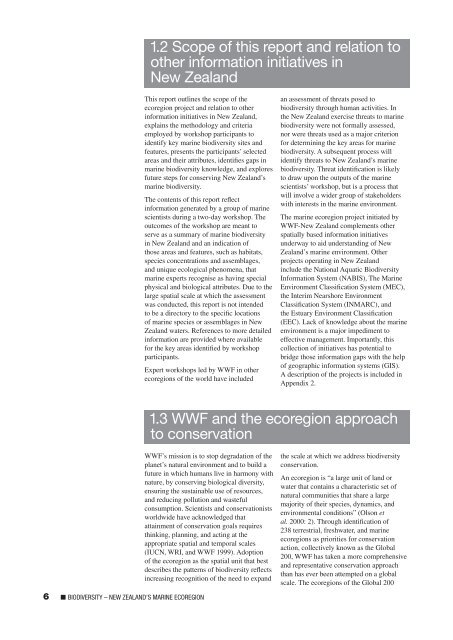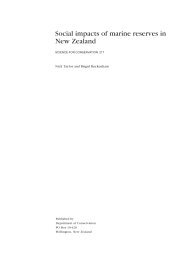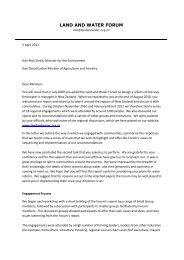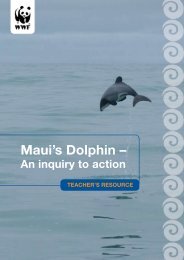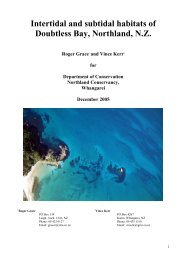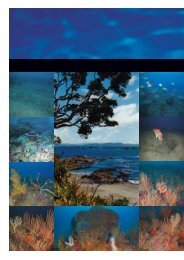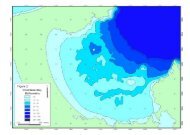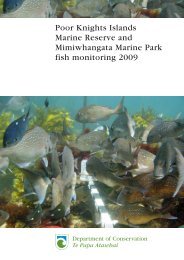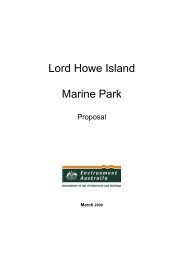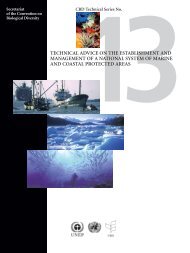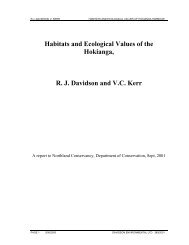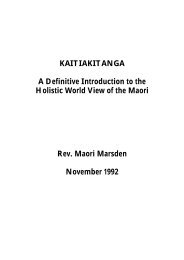WWF Shining a spotlight on the biodiversity of ... - MarineNZ.org.nz
WWF Shining a spotlight on the biodiversity of ... - MarineNZ.org.nz
WWF Shining a spotlight on the biodiversity of ... - MarineNZ.org.nz
Create successful ePaper yourself
Turn your PDF publications into a flip-book with our unique Google optimized e-Paper software.
1.2 Scope <strong>of</strong> this report and relati<strong>on</strong> to<br />
o<strong>the</strong>r informati<strong>on</strong> initiatives in<br />
New Zealand<br />
This report outlines <strong>the</strong> scope <strong>of</strong> <strong>the</strong><br />
ecoregi<strong>on</strong> project and relati<strong>on</strong> to o<strong>the</strong>r<br />
informati<strong>on</strong> initiatives in New Zealand,<br />
explains <strong>the</strong> methodology and criteria<br />
employed by workshop participants to<br />
identify key marine <strong>biodiversity</strong> sites and<br />
features, presents <strong>the</strong> participants’ selected<br />
areas and <strong>the</strong>ir attributes, identifies gaps in<br />
marine <strong>biodiversity</strong> knowledge, and explores<br />
future steps for c<strong>on</strong>serving New Zealand’s<br />
marine <strong>biodiversity</strong>.<br />
The c<strong>on</strong>tents <strong>of</strong> this report reflect<br />
informati<strong>on</strong> generated by a group <strong>of</strong> marine<br />
scientists during a two-day workshop. The<br />
outcomes <strong>of</strong> <strong>the</strong> workshop are meant to<br />
serve as a summary <strong>of</strong> marine <strong>biodiversity</strong><br />
in New Zealand and an indicati<strong>on</strong> <strong>of</strong><br />
those areas and features, such as habitats,<br />
species c<strong>on</strong>centrati<strong>on</strong>s and assemblages,<br />
and unique ecological phenomena, that<br />
marine experts recognise as having special<br />
physical and biological attributes. Due to <strong>the</strong><br />
large spatial scale at which <strong>the</strong> assessment<br />
was c<strong>on</strong>ducted, this report is not intended<br />
to be a directory to <strong>the</strong> specific locati<strong>on</strong>s<br />
<strong>of</strong> marine species or assemblages in New<br />
Zealand waters. References to more detailed<br />
informati<strong>on</strong> are provided where available<br />
for <strong>the</strong> key areas identified by workshop<br />
participants.<br />
Expert workshops led by <str<strong>on</strong>g>WWF</str<strong>on</strong>g> in o<strong>the</strong>r<br />
ecoregi<strong>on</strong>s <strong>of</strong> <strong>the</strong> world have included<br />
an assessment <strong>of</strong> threats posed to<br />
<strong>biodiversity</strong> through human activities. In<br />
<strong>the</strong> New Zealand exercise threats to marine<br />
<strong>biodiversity</strong> were not formally assessed,<br />
nor were threats used as a major criteri<strong>on</strong><br />
for determining <strong>the</strong> key areas for marine<br />
<strong>biodiversity</strong>. A subsequent process will<br />
identify threats to New Zealand’s marine<br />
<strong>biodiversity</strong>. Threat identificati<strong>on</strong> is likely<br />
to draw up<strong>on</strong> <strong>the</strong> outputs <strong>of</strong> <strong>the</strong> marine<br />
scientists’ workshop, but is a process that<br />
will involve a wider group <strong>of</strong> stakeholders<br />
with interests in <strong>the</strong> marine envir<strong>on</strong>ment.<br />
The marine ecoregi<strong>on</strong> project initiated by<br />
<str<strong>on</strong>g>WWF</str<strong>on</strong>g>-New Zealand complements o<strong>the</strong>r<br />
spatially based informati<strong>on</strong> initiatives<br />
underway to aid understanding <strong>of</strong> New<br />
Zealand’s marine envir<strong>on</strong>ment. O<strong>the</strong>r<br />
projects operating in New Zealand<br />
include <strong>the</strong> Nati<strong>on</strong>al Aquatic Biodiversity<br />
Informati<strong>on</strong> System (NABIS), The Marine<br />
Envir<strong>on</strong>ment Classificati<strong>on</strong> System (MEC),<br />
<strong>the</strong> Interim Nearshore Envir<strong>on</strong>ment<br />
Classificati<strong>on</strong> System (INMARC), and<br />
<strong>the</strong> Estuary Envir<strong>on</strong>ment Classificati<strong>on</strong><br />
(EEC). Lack <strong>of</strong> knowledge about <strong>the</strong> marine<br />
envir<strong>on</strong>ment is a major impediment to<br />
effective management. Importantly, this<br />
collecti<strong>on</strong> <strong>of</strong> initiatives has potential to<br />
bridge those informati<strong>on</strong> gaps with <strong>the</strong> help<br />
<strong>of</strong> geographic informati<strong>on</strong> systems (GIS).<br />
A descripti<strong>on</strong> <strong>of</strong> <strong>the</strong> projects is included in<br />
Appendix 2.<br />
1.3 <str<strong>on</strong>g>WWF</str<strong>on</strong>g> and <strong>the</strong> ecoregi<strong>on</strong> approach<br />
to c<strong>on</strong>servati<strong>on</strong><br />
<str<strong>on</strong>g>WWF</str<strong>on</strong>g>’s missi<strong>on</strong> is to stop degradati<strong>on</strong> <strong>of</strong> <strong>the</strong><br />
planet’s natural envir<strong>on</strong>ment and to build a<br />
future in which humans live in harm<strong>on</strong>y with<br />
nature, by c<strong>on</strong>serving biological diversity,<br />
ensuring <strong>the</strong> sustainable use <strong>of</strong> resources,<br />
and reducing polluti<strong>on</strong> and wasteful<br />
c<strong>on</strong>sumpti<strong>on</strong>. Scientists and c<strong>on</strong>servati<strong>on</strong>ists<br />
worldwide have acknowledged that<br />
attainment <strong>of</strong> c<strong>on</strong>servati<strong>on</strong> goals requires<br />
thinking, planning, and acting at <strong>the</strong><br />
appropriate spatial and temporal scales<br />
(IUCN, WRI, and <str<strong>on</strong>g>WWF</str<strong>on</strong>g> 1999). Adopti<strong>on</strong><br />
<strong>of</strong> <strong>the</strong> ecoregi<strong>on</strong> as <strong>the</strong> spatial unit that best<br />
describes <strong>the</strong> patterns <strong>of</strong> <strong>biodiversity</strong> reflects<br />
increasing recogniti<strong>on</strong> <strong>of</strong> <strong>the</strong> need to expand<br />
<strong>the</strong> scale at which we address <strong>biodiversity</strong><br />
c<strong>on</strong>servati<strong>on</strong>.<br />
An ecoregi<strong>on</strong> is “a large unit <strong>of</strong> land or<br />
water that c<strong>on</strong>tains a characteristic set <strong>of</strong><br />
natural communities that share a large<br />
majority <strong>of</strong> <strong>the</strong>ir species, dynamics, and<br />
envir<strong>on</strong>mental c<strong>on</strong>diti<strong>on</strong>s” (Ols<strong>on</strong> et<br />
al. 2000: 2). Through identificati<strong>on</strong> <strong>of</strong><br />
238 terrestrial, freshwater, and marine<br />
ecoregi<strong>on</strong>s as priorities for c<strong>on</strong>servati<strong>on</strong><br />
acti<strong>on</strong>, collectively known as <strong>the</strong> Global<br />
200, <str<strong>on</strong>g>WWF</str<strong>on</strong>g> has taken a more comprehensive<br />
and representative c<strong>on</strong>servati<strong>on</strong> approach<br />
than has ever been attempted <strong>on</strong> a global<br />
scale. The ecoregi<strong>on</strong>s <strong>of</strong> <strong>the</strong> Global 200<br />
6 ■ BIODIVERSITY – NEW ZEALAND’S MARINE ECOREGION


